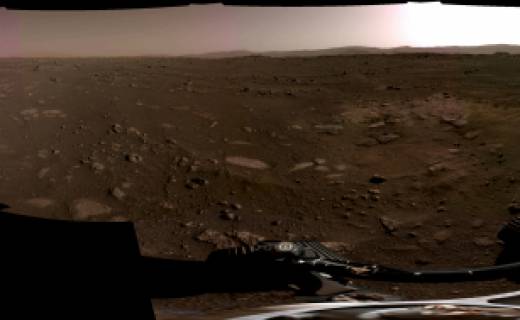“Listen to the sound of the Martian wind.”
The National Aeronautics and Space Administration (NASA) released the sound of Martian wind recorded by the exploration rover’Perseverance’ on the 22nd (local time), AFP news agency reported.
The communication said, “The exploration rover recorded the faint Martian wind,” and this is the first time the Martian breeze has been transmitted to Earth.
NASA uploaded two 18-second audio files on its home page that contain the sound of the winds on Mars.
One was the audio with the rover mechanical sound, and the other was the pure wind that the’Red Planet’ heard for the first time to Earth people with the rover sound removed.
NASA emphasized that “the actual sound of the Martian winds captured by a microphone mounted on an exploration rover and sent to us on Earth.”

A panoramic photo of six images taken from the surface of Mars on the 20th (local time) of a camera mounted on the NASA’s exploration rover’Perseverance’./Yonhap News/
“Put your headphones on and listen to the first (Mars) sound picked up by one of my microphones,” Perseverance said via Twitter.
In addition, NASA also released vivid images of the landing on Mars sent by the exploration rover. This is the first time that the moment an exploration rover lands on Mars as if watching an actual TV broadcast.
The exploration rover’s entry, descent, and landing (EDL) on Mars is the most difficult and dangerous during flight, so it is called ‘7 minutes of horror’.
The video started almost four minutes after the rover entered Mars’ atmosphere. The rover parachuted 7 miles (11.2 km) above Mars, and the aircraft shook gently.
Soon, the heat shield, blocking the frictional heat in the atmosphere, fell off, and the rover descended at a speed of 145m per second, illuminating the red earth on Mars with the camera.
Relying on a parachute, the rover descends at a speed of 100 meters per second from a point of 6.6 kilometers above the ground, and searched for a safe landing site using’Terrain-Relative Navigation’.
After that, the rover, which slowed down to 30 meters per second from 300 meters above the ground, soon switched to a’sky crane’ maneuver that attempted a safe landing by hanging on three 6.4 meters of nylon cables.
Just before the rover’s wheel touched, the reverse propulsion of the’Jetpack’ engine caused a rough wind to hit the Mars ground, and the rover settled in red dust.
NASA Deputy Director Thomas Zuberken said, “This is the closest video to see the Mars landing without wearing a spacesuit.”
Michael Watkins, director of NASA’s Jet Propulsion Research Institute (JTL), said, “Now we can see the process we call ‘7 minutes of horror’ as if we were watching it in the first row of the stage. It’s really a wonder to see them blow up.”
